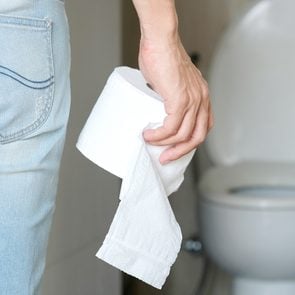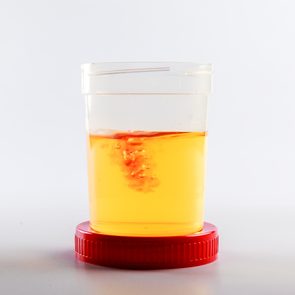Andrea Macasaet looks on the bright side—that’s her thing. This past fall, when Broadway’s theatres reopened, she starred as Anne Boleyn in Six, a musical about Henry VIII’s wives. She doesn’t moan about how COVID cancelled her originally scheduled debut back in 2020. She’d just finished 36 preview performances at the storied Brooks Atkinson Theater when she heard that New York state’s governor had ordered a lockdown.
Her friends and family were in town for a double celebration—her 26th birthday was the next day. “I thought, that’s OK, we’re all tired,” she recalls. “I assumed it would be just a short delay, a few weeks or so.” Then the weeks stretched to months, and then to over a year. Macasaet, now 27, remains grateful and upbeat—especially because, at one point in her life, she almost gave up on the theatre altogether.
As a kid, she fell in love with the stage. She got her start performing in karaoke competitions run by Winnipeg’s large Filipino-Canadian community, encouraged by her parents, both immigrants from the Philippines. With a repertoire of Céline Dion, Whitney Houston and the plaintive “On My Own” from Les Misérables, she tried, always, to “make them feel it”—her mother’s advice.
From there, she performed in the children’s chorus in The King & I and played a pepper shaker in Beauty and the Beast. When she was 19, after many auditions and minor parts, she thought she was finally on her way when she was cast in the title role in Miss Saigon in Victoria, B.C., where she’d gone to theatre school.
But then the big roles stopped coming. “I just felt they weren’t seeing me in the auditions, not hearing me,” she says. She took a job at Lululemon to help support herself while she went from one dispiriting audition to the next. She finally decided she’d had enough and signed up for human resources courses at the University of Winnipeg.
But if she was prepared to let her dreams go, they weren’t quite done with her. On campus one day, she noticed online that a theatre in Edmonton was casting for a musical that reimagined Henry VIII’s wives as a girl group who belt out poppy songs about which one of them had it the worst. Written by two young Cambridge grads, it had done well in London’s West End and was slated for a North American tour.
She sent in a video of herself singing Lady Gaga’s “I’ll Never Love Again.” A call came on a Thursday—could she come to Toronto on Monday?
The show’s co-creator and director, Lucy Moss, was wowed: “She had this voice, of course, but there was something else, this concentrated hilarity. At one point, we all started giggling. It was that rare thing where you looked all down the panel and everyone knew, we’ve got our Boleyn.”
Macasaet is, indeed, funny but also earnest—and always shifting between the two modes, talking one moment about prepping for the role by reading up on Tudor history, the next about watching a big Beyoncé concert for tips. Onstage, she also moves rapidly from singing in anthem mode to serving up sly humour—and Boleyn’s main solo number, “Don’t Lose Ur Head,” gives her plenty of space to do both.
Though the tour went well, with audiences packing the houses in Edmonton, Chicago and Boston, it wasn’t a given that she’d get to play it in New York. The big stages had always seemed so far out of reach. “Growing up, I used to hum and sing all these Disney princess songs,” she says. “But I couldn’t picture myself as Cinderella or Ariel.” Then she got the call. “When I received the offer for Broadway, I was in the car with my best friend and sister,” she says. “We had just come from brunch. I had to pull over to cry.”
In her positive, no-nonsense way, Macasaet recognizes she’s not alone in her struggles: she’s on a continuum of women breaking barriers in theatre. Even getting the lead in Miss Saigon—which some critics have argued perpetuates hoary Western stereotypes of Asian women—connected her to an idol. “Lea Salonga, the woman who originated the role of Kim in Miss Saigon, is iconic in the Filipino community,” she says. “She allowed me to believe that a career in theatre was tangible. If Lea could do it, so could I.”
Macasaet wants to pass that sense of possibility on to the next generation. “The feeling of being up there, there’s nothing like it.”
For more inspiration, check out these good news stories that are sure to brighten your day.
Why does it burn when I pee?
If you’re thinking, “It burns when I pee,” the stinging sensation could signal an infection or even just irritation from food, drugs, or medication. The sensation usually comes with other symptoms as well, which can help determine the cause (and the treatment).
“It’s pretty unusual to just have burning,” says Elizabeth Kavaler, MD, a urologist with Lenox Hill Hospital in New York City and author of A Seat on the Aisle, Please!: The Essential Guide to Urinary Tract Problems in Women. “Usually, other things go with it.”
That could be urine that’s cloudy or differs in colour, odour, or frequency. Here are the reasons why it may hurt or burn when you pee.
Urinary tract infection
“The most common problem that patients have when they talk about burning during urination is a urinary tract infection,” says Anthony Schaeffer, MD, a urologist at Northwestern Memorial Hospital in Chicago. That’s especially true if the symptoms come on suddenly and you’re a woman. In fact, 50 per cent or more of women will get a urinary tract infection or UTI at some point during their lifetime.
If you have a UTI, the burning sensation when you pee is usually accompanied with a feeling that you need to go all the time and sometimes cloudy urine. Ninety per cent of UTIs are caused by the bacterium Escherichia coli (E. coli), which can be treated with antibiotics.
Irritation and sensitivity
You may feel burning when you pee, but not have an infection. Anything that irritates your urinary tract (which includes your kidneys, bladder, ureters, and urethra) can cause these sensations.
“If the skin is raw or chafed or irritated or if the urine is acidic, then it could burn,” says Dr. Kavaler.
The list of culprits is long: acidic food like citrus fruits, drinks with alcohol or caffeine or ingredients in bubble baths, soaps, douches, contraceptive foams or sponges, and more. The best solution is to identify and remove the offender. (Here are the 13 things your urologist wants you to know.)
Bladder and kidney stones
These stones, most often formed from calcium, can grow large enough to block parts of the urinary tract. That impedes the flow of urine, which leads to stinging and burning when you pee. Unlike UTIs, these are more common in men. Frequent UTIs can actually lead to stones, as can not drinking enough water, being obese, and fluid loss from frequent diarrhea, which itself could come from a medical condition like Crohn’s disease.
Other symptoms can include that urgent need to go, dark or bloody urine, nausea, and vomiting, cramping in your back and side, and not actually passing much urine. Ovarian cysts pressing on the bladder may also affect how you urinate. Take heart: Most are benign and may even go away on their own—although you should consult your doctor. (Read the story of a young woman who thought she had a UTI—but it turned out to be a rare kidney disorder.)
Vaginitis
One-third of women will develop vaginitis or inflammation of the vagina during their lifetime. It’s caused by anything that changes the natural flora (resident bacteria and other organisms) in that area. That could be a yeast infection, intercourse, antibiotic use, fluctuating hormone levels during pregnancy or menopause, chemicals from douching, or spermicides.
Sexually transmitted diseases
Although many sexually transmitted diseases (STDs) have no symptoms, some do announce themselves with urination that burns, especially gonorrhea, herpes, chlamydia, and syphilis.
“Sexually transmitted diseases can give a pain sensation and burning,” says Dr. Schaffer. “If someone is sexually active, then they should be evaluated.”
Along with UTIs, this is one of the top two causes of painful urination in women. If you suspect you have an STD, it’s important to get it checked out by a medical professional so they can prescribe treatment.
Pelvic floor disorder
This is a muscular condition that has nothing to do with infections, says Dr. Kavaler. The pelvic floor is a collection of muscles that support the bladder, uterus, prostate, and other organs in your pelvic area. It may be associated with interstitial cystitis (IC) or bladder pain syndrome, but no one has pinpointed exactly what causes IC. Along with the pain, while peeing, you may also feel a frequent, urgent need to get to the bathroom.
Prostate problems
In men, the urethra, which transports urine out of the body, passes through the prostate gland. Prostatitis (inflammation) can disrupt urination. Often it’s an infection that causes the inflammation or, in older men, it could be due to benign prostatic hyperplasia (BPH), commonly called an enlarged prostate. You may also experience having to pee often (at least eight times in a 24-hour period), urgency, or needing to pee at night.
Medication
Some drugs can cause painful urination, namely chemotherapy and radiation treatments for cancer. Surgery in the urinary tract and pelvic areas can also contribute. The most common chemotherapy drugs to damage the bladder are cyclophosphamide (Procytox) and ifosfamide (Ifex). They can also up the risk for UTIs.
If you have side effects from cancer treatment, the National Cancer Institute recommends drinking a lot of water and keeping in touch with your oncologist on ways to prevent symptoms.
When to see a doctor
For some people, painful urination goes away on its own, while others have success with home remedies like drinking cranberry juice (for UTIs) or avoiding bubble baths. Often the pain is so distressful you’ll head to the doctor.
If the symptom doesn’t go away and if you have bloody urine, any changes in the colour or odour of your urine, a fever, or pain in your back and side, see a doctor. Also, seek help if you’re pregnant or have an immune condition.
“A doctor will put all the information together and look at treatments,” says Dr. Kavaler.
Next, check out what it could mean if you get up to pee every night.
The ongoing experiment
It’s a humid summer afternoon and a minivan is packed with hungry children. There isn’t time to cook before tonight’s soccer game, so their father pulls into the McDonald’s drive-thru and places his order. The children whine; the vein on his left temple pulses. After a long eight minutes, he rolls down the window, and with a mumbled “sorry,” a teen hands him a family-size pizza. This is London, Ont., in the mid-eighties.
This seemingly normal scenario, which likely occurred hundreds of times, is actually not at all normal in one noteworthy way: few communities in North America had McDonald’s pizza then. London was among the first to get it before it spread slowly across the continent. People loved the pizzas; they became legendary. But a dish that took nearly 10 minutes to make wasn’t exactly “fast food.” Couple that with thousands of franchisees saddled with the cost of installing new ovens and the whole idea eventually fizzled out.
The thing is, the hypothetical father at the drive-thru didn’t know any of this. He was just looking for the welcome silence that comes from filling kids’ mouths with pepperoni and cheese. He didn’t know that London was at the centre of an ongoing experiment in North American consumer habits. And he didn’t know that, to some shadowy figures watching from afar, he and his family were considered the most typical, representative people in the country.
Most residents of London go through life unaware of the part they play in a conspiracy stretching from corporate boardrooms in New York and Toronto to the fast-food restaurants of southern Ontario. London is, in fact, a principal test market for new consumer products in Canada—and even for the United States.
Newly invented goods slide discreetly into their displays. And then market researchers in the big cities watch. They count how many Krispy Kremes get eaten and notice who opts for peach Pepsi. By the time the goods make it to Toronto or Ottawa, they may feel new, but they’re not: they’ve been tried by the citizens of London.
Extraordinarily normal
Companies love London because it is deeply, beautifully average. It’s a medium-size city, just under half a million people living in its broader metropolitan area. Larger cities pose the logistical problem of testing evenly across the populace while smaller ones don’t have big-enough consumer pools to get an accurate reading.
London’s employment breakdown is a diverse mix of occupations, industries and incomes. It’s home to two major post-secondary institutions, a large manufacturing sector and plenty of service jobs. London has a wide range of ethnicities, too. About 140 languages are spoken there; immigrants make up about a fifth of the population.
Kapil Lakhotia, president and CEO of the London Economic Development Corporation, explains that it is the confluence of all these factors that makes London such an irresistible place for companies to float new products. Other cities may have some of these criteria, but not all of them together. You could even say that London is one-of-a-kind—at least for the purpose of market research.
London also has a bit of a cautious, conservative disposition. But unadventurousness is actually a good thing for a test market: companies can be confident that if Londoners latch on to something, they must really like it. The city is content, after all, with not even having its own name. If you were from London, as I am, you would often hear yourself sigh as you explained for the hundredth time, “No, the other London.”
“We’re bigger than London, Kentucky,” I sometimes like to add.
I’d always been dimly aware that, in London, we were guinea pigs. And after some research, I’ve realized just how much this was true.
McDonald’s, Tim Hortons and IKEA
The first McDonald’s in eastern Canada was opened in London in 1968. It was a big hit, paving the way for a national rollout. The retro golden arches of that first location still rise above Oxford Street. (When it comes to their pizza saga, it definitely came to London early, but it’s difficult to get a hard date; my father recalls buying them in the early nineties, about five years before they hit the general market.)
The Tim Hortons Iced Capp, that mix of sickly sweet coffee syrup and ice mush that powers Canadians through the summer months, is said to have first appeared in London. The Beer Store introduced drive-thru pickup there (along with a couple other locations nearby). It’s pretty convenient—you roll up and get handed a two-four through the window. Despite some concerns initially that it would encourage drunk driving, it has lasted to the present day.
A few years back, IKEA brought furniture pickup points to Canada, starting in London. For years, Londoners had to schlep an hour and a half to Burlington for their unassembled Swedish furniture. Now, not only were they able to order products and pick them up on Wonderland Road, they were the only ones in Canada who had that luxury.
In the early 1980s, Canada Trust Bank—now TD Bank—introduced its first-ever ATMs in London, at least according to oral history. They weren’t called that; they were dubbed “Johnny Cash Machines.” (Another fun fact about London: it claims Johnny Cash as part of local lore, since he proposed to June Carter on stage there in 1968.) The Cash-themed cash machines were later rolled out across Canada as a promotional scheme before the bank switched to the normal, Johnny-less version.
In terms of sheer scale, the most significant product tested in London is probably the McDonald’s Chicken McNugget. In 1983 those little chunks of assembly-line meat hit the city—and Londoners must’ve liked them, since the rest is caloric history.
A meaningful absence
I quickly learned during this investigation, though, that getting definitive facts is tough. Test-marketing is a highly secretive process. My attempts to contact the companies for confirmation proved fruitless—it turns out that Tim Hortons, for example, doesn’t like to talk about products it tests, especially if they aren’t popular.
For the longest time, there was one thing I remembered growing up that I could not confirm outside of my own memory—that McDonald’s made a veggie burger in the early 2000s. I knew this because I most certainly ate them. This was before any other major fast-food outlets had them on their menus, and I can still vividly remember how it looked—a greasy brown puck that didn’t make any false promises. It was a thrill to a young vegetarian, but then it disappeared. I didn’t know it was a test at the time, a soy-based mirage. I only finally verified its existence when I came across a report last September that made reference to this McVeggie Deluxe, almost two decades later, while announcing that McDonald’s was testing a new plant-based burger—called the PLT—in, of course, London.
Many Londoners must have similar memories that aren’t ever substantiated like mine was, and wonder if they’re just imagining them. Among my friends and family, a few people can remember getting McDonald’s delivery in the nineties, like I do. Many more, however, have no idea what I’m talking about.
Growing up in London, you’re often aware of an absence. There isn’t an easily identifiable culture like the ones my friends had who grew up in bigger Canadian cities. But maybe there’s meaning in this contribution our populace has made to the country. Every time you enjoy Chicken McNuggets or an Iced Capp, thank the average citizens of London for trying them first—and liking them.
Next, find out why Newfoundland is the kindest province.
© 2019, Nicholas D’Ascanio. From ‘’Norm Core,” by Nicholas D’Ascanio, published in Maisonneuve (September 27, 2019), Maisonneuve.org.





